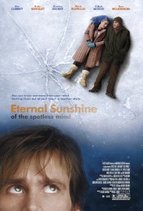
A film of such rank is, Eternal Sunshine of the Spotless Mind. The film breaks almost all of the conventions of the classical Hollywood cinema – continuity, lighting, framing, unity, storytelling, comprehension and emotional appeal to a certain class.
Eternal Sunshine of the Spotless Mind explodes with new ideas and in the process the Aristotelian sense of realism is completely forgotten. The whole film takes place in two “realities”. The first of those two, and the bigger one, is everything that happens in Joel’s mind. About 70% of the action takes place there. The second “reality” is the real world, where the attempt to erase Clementine from Joel’s mind takes place. Sometimes I was lost while watching the film, I was not sure where I was, but it was O.K. because it stimulated my mind to think and actively comprehend the images and the plot.
At the same time we have to figure out what is real and where the action takes place. The film begins in the middle, after Joel’s memories of Clementine are erased already, and then 30 minutes into the film we are shown the beginning of the story. By doing that the filmmaker shifts away from the relation between space, time and narrative logic.
In the film, different locations are linked that have nothing in common. This way the “invisible” techniques of storytelling are completely abandoned and the time and space portrayed are not secondary to the plot. Thus the storytelling draws attention to itself and keeps us intrigued and constantly thinking instead of just consuming what is being fed to us.
At first glance Eternal Sunshine of the Spotless Mind is about guy that wants to forget a girl that he loved. But all that is symbolic. The film explores love, memory, and the tension between forgetting a painful past, moving on with life and trying to build a happy future. During the process of erasing selected memories, Joel reaches the conclusion that memories are good and useful. If the past is useless information and not worth remembering, then we will move in circular motion and repeat the mistakes we have made before. If we have our memory selectively erased then everything that happened before is destined to happen again. We would not recognize it or learn from it, exactly what happens in the film – both of them meet again and are attracted to each other in a very strange way.
Eternal Sunshine of the Spotless Mind is a demonstration of the fine art of filmmaking. All the elements of filmmaking- camera style, editing, cinematography and sound effects, gel perfectly into a coherent film with the qualities and characteristics of the highest rank.
 RSS Feed
RSS Feed